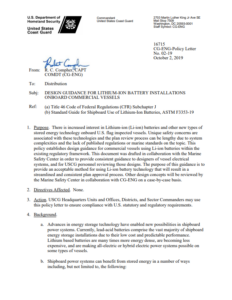USCG’s Office of Design and Engineering Standards (CG-ENG) issued CG-ENG Policy Letter No. 02-19, “Design Guidance for Lithium-Ion Battery Installations Onboard Commercial Vessels” to improve the plan approval process for commercial vessel propulsion or electrical systems powered by installed Lithium-ion batteries.
Concerning the increased interest in Lithium-ion batteries, many are the concerns following due to the complexity of the systems and the lack of regulations or marine standards on the topic, resulting to accidents. Therefore, the newly-launched policy provides guidance for commercial vessels using Li-ion batteries within the existing regulatory framework.
The purpose of this guidance is to provide an acceptable method for using Li-ion battery technology that will result in a streamlined and consistent plan approval process. Other design concepts will be reviewed by the Marine Safety Center in collaboration with CG-ENG on a case-by-case basis.
Guidance on the design of lithium ion battery installations:
- Testing requirements – Battery design tests such as short circuit, impact, and overcharging.
- Operating environment – Control and monitoring of the shipboard battery operating environment.
- Fire safety – Measures to detect, contain, and mitigate emergency situations through battery temperature monitoring, structural fire protection, fire detection, and fire-fighting systems.
- Battery system design – Battery Management System (BMS) requirements.
- Testing and maintenance – Testing procedures for automation systems installed in vessel propulsion, ships service electrical or emergency power applications.
In light of the following, USCG proposes that the guide can be used as an acceptable method for installing Li-ion battery power systems onboard commercial vessels.
Additionally, the Marine Safety Centre addresses more design criteria that could be applied based on a risk assessment of the specific vessel:
- The Officer in Charge of Marine Inspection (OCMI) may determine that certain operational restrictions should be applied based on the vessel’s route and operating conditions
- Vessels subject to 46 CFR Subchapter T may propose a reduction in some of the requirements of ASTM F3353 for installations with an overall battery capacity less than or equal to 50 kWh.
Moreover, subject to the batteries’ verification and maintenance, the batteries are complex and based on automated systems for charging, monitoring and control of emergency situations.
Thus, users and stakeholders should verify that a battery system is installed and maintained in accordance with approved plans, to ensure safe and reliable operations.
To explore more, click on the PDF herebelow


































































